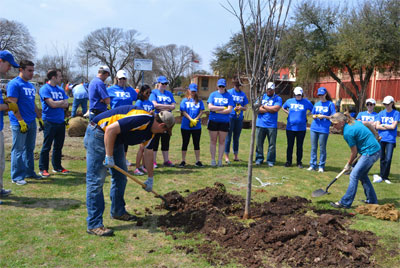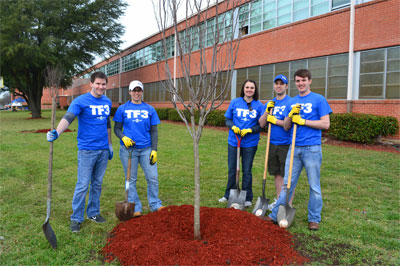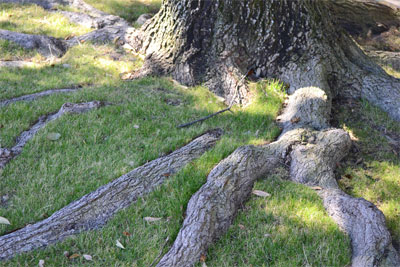Texas Tree Tips: April 2014

Arborists instruct volunteers about the basics and finer points of sustainable tree planting at a recent Trees for Threes planting event. Photos by Bill Seaman.
By Steve Houser
Tree Planting During a Drought?
“We are in a drought and you guys are planting trees! Are you crazy?”
This question was posed during a recent tree-planting event sponsored by the Dallas Mavericks and PwC (PricewaterhouseCoopers). Trees for Threes, or TF3 for short, plants a large tree at a Dallas-area school for each three-point shot scored by the Mavs. The trees are irrigated and maintained for three years to help ensure their survival. Now in its fifth year, Trees for Threes has planted more than 1,000 trees on DISD school campuses. (http://www.mavs.com/community/events/trees-for-threes/).

This newly planted tree will soon generate cooling shade, help clean the air, and reduce storm water runoff.
Since trees need water to survive and grow, it seems only a tree hugger would promote tree planting during a drought. However, if you care about water quality or quantity, you should also care about trees. There is a direct link between them.
Water Quality
Trees are not only big air filters; they also help to filter our water. Trees remove water from the soil, where the water starts its journey through a tree’s vascular system and is released into the air in a fine mist. The process is called transpiration. A single tree can emit up to 400 gallons of water in a day. The water is cleaned as it travels through the vascular system. A tree that cleans 300 gallons a day will clean 109,500 gallons of water in a year.
The watersheds of Lake Lewisville and Lake Arlington were previously researched by Vision North Texas and the North Central Texas Council of Governments using a “greenprinting” tool developed by the Trust for Public Land. The study found that maintaining natural and undeveloped areas and forests in the watershed offered significant benefits to water quality. www.nctcog.org/watershed

Tree roots help filter ground water and reduce soil erosion.
Water is also filtered as it travels through tree roots and seeps into our groundwater. Research shows that some tree species break down water pollutants, including metals, pesticides, and solvents. Research also shows that tree roots prevent erosion of precious topsoil by stabilizing the soil and dispersing rainfall.
Water Quantity
Research from Russian physicists Victor Gorshkov and Anastassia Makarieva produced the biotic pump theory, which postulates that trees are the driving force behind rainfall over land. If you live in a desert, you have very little rainfall. Well duh! But it leads to the question of why? Tree transpiration may play a role. If a typical tree transpires hundreds of gallons of water per day, multiply this number times the number of trees on earth and it seems reasonable that rainfall totals could be affected.
If rainfall occurs over a hard surface such as concrete or asphalt, it quickly runs off, greatly increasing the amount of water leaving a site and creating the potential for flooding downstream. Tree foliage helps to reduce the amount of water runoff by holding it on the surface area of leaves and stems — and then slowly releasing it as it drips off or evaporates. More tree foliage on a site equals more water that enters into the soil, which helps to reduce the potential for drought problems. Research shows that tree canopy cover reduces storm water storage costs by billions of dollars in urban areas throughout the country. Shade from trees reduces the evaporation of soil moisture, reducing the need for landscape irrigation for the plants underneath the trees’ canopy.
Water is the element that gives life. If you truly care about water, you should also care about the trees, forests, and the natural ecology in your area. Who knows, someday it might even be cool to be a tree hugger! Stranger things have happened.
I say, “Ask not what trees do for you, but rather, what you can do for trees!”

